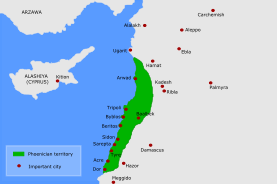Ezekiel 27
Ezekiel 27 is the twenty-seventh chapter of the Book of Ezekiel in the Hebrew Bible or the Old Testament of the Christian Bible. This book contains the prophecies attributed to the prophet/priest Ezekiel, and is one of the Books of the Prophets. This chapter contains a lamentation for the fallen city of Tyre.[1]
| Ezekiel 27 | |
|---|---|
 Book of Ezekiel 30:13–18 in an English manuscript from the early 13th century, MS. Bodl. Or. 62, fol. 59a. A Latin translation appears in the margins with further interlineations above the Hebrew. | |
| Book | Book of Ezekiel |
| Hebrew Bible part | Nevi'im |
| Order in the Hebrew part | 7 |
| Category | Latter Prophets |
| Christian Bible part | Old Testament |
| Order in the Christian part | 26 |
Text
The original text was written in the Hebrew language. This chapter is divided into 36 verses.
Textual witnesses

Some early manuscripts containing the text of this chapter in Hebrew are of the Masoretic Text tradition, which includes the Codex Cairensis (895), the Petersburg Codex of the Prophets (916), Aleppo Codex (10th century), Codex Leningradensis (1008).[2]
There is also a translation into Koine Greek known as the Septuagint, made in the last few centuries BC. Extant ancient manuscripts of the Septuagint version include Codex Vaticanus (B; B; 4th century), Codex Alexandrinus (A; A; 5th century) and Codex Marchalianus (Q; Q; 6th century).[3][lower-alpha 1]


Verse 2
- "Son of man" (Hebrew: בן־אדם ḇen-’ā-ḏām): this phrase is used 93 times to address Ezekiel.[6]
- "Lamentation" (Hebrew: קינה qî-nāh; plural: קִינִים in Ezekiel 2:10 or קִּינֽוֹת in 2 Chronicles 35:25): the Hebrew word has a meaning of "elegy, dirge", "a mournful song",[7][8] a funeral song in the New Living Translation.[9]
The people of Tyre, seeing themselves as the great merchants, will have a great downfall despite their past glory.[10] A similarly worded lament for Babylon the Great appears in the New Testament in Revelation 18:11-16.
Verse 3a
- and say to Tyre, which sits at the entrance to the sea, merchant of the peoples on many coastlands ...[11]
The word for "entrance" or "gateway" is literally "entries" (plural), "reference possibly being to the two harbours of Tyre, one of which was to the north east of the island, called the Sidonian harbour, because looking towards Sidon, and the other on the south or south-east of the island, the exact position of which is uncertain owing to the silting which has taken place".[12] Ancient Tyre was on an island, which is now connected to the mainland by a causeway.
Notes
- Ezekiel is missing from the extant Codex Sinaiticus.[4]
References
- Ezekiel 27:1-36: chapter heading in the New King James Version
- Würthwein 1995, pp. 35-37.
- Würthwein 1995, pp. 73-74.
- Shepherd, Michael (2018). A Commentary on the Book of the Twelve: The Minor Prophets. Kregel Exegetical Library. Kregel Academic. p. 13. ISBN 978-0825444593.
- Ezekiel 27:2: NKJV
- Bromiley 1995, p. 574.
- Brown, Briggs & Driver 1994 "קִינָה"
- Gesenius 1979 "קִינָה"
- Ezekiel 27:2: NLT
- The New Oxford Annotated Bible with the Apocrypha, Augmented Third Edition, New Revised Standard Version, Indexed. Michael D. Coogan, Marc Brettler, Carol A. Newsom, Editors. Publisher: Oxford University Press, USA; 2007. pp. 1217-1219 Hebrew Bible. ISBN 978-0195288810
- Ezekiel 27:3: NRSV
- Davidson A. B. (1893), Cambridge Bible for Schools and Colleges on Ezekiel 27, accessed 15 December 2019
Bibliography
- Bromiley, Geoffrey W. (1995). International Standard Bible Encyclopedia: vol. iv, Q-Z. Eerdmans.CS1 maint: ref=harv (link)
- Brown, Francis; Briggs, Charles A.; Driver, S. R. (1994). The Brown-Driver-Briggs Hebrew and English Lexicon (reprint ed.). Hendrickson Publishers. ISBN 978-1565632066.
- Clements, Ronald E (1996). Ezekiel. Westminster John Knox Press. ISBN 9780664252724.CS1 maint: ref=harv (link)
- Gesenius, H. W. F. (1979). Gesenius' Hebrew and Chaldee Lexicon to the Old Testament Scriptures: Numerically Coded to Strong's Exhaustive Concordance, with an English Index. Translated by Tregelles, Samuel Prideaux (7th ed.). Baker Book House.
- Joyce, Paul M. (2009). Ezekiel: A Commentary. Continuum. ISBN 9780567483614.CS1 maint: ref=harv (link)
- Würthwein, Ernst (1995). The Text of the Old Testament. Translated by Rhodes, Erroll F. Grand Rapids, MI: Wm. B. Eerdmans. ISBN 0-8028-0788-7. Retrieved January 26, 2019.